JUC并发
什么是JUC
JUC就是java.util .concurrent工具包的简称。这是一个处理线程的工具包,JDK 1.5开始出现的。

业务:普通的线程代码,Thread。
Runable 没有返回值,效率比 Callable 低。
进程和线程
进程:操作系统中运行的程序就是线程,一个进程可以包含多个线程,是系统资源分配的的单位。Java默认线程:main线程,GC线程。
线程:系统运算调度的单位,是进程中实际的运作单位。
Java可以开启线程吗?
Thread部分源码:
public synchronized void start() {
if (threadStatus != 0)
throw new IllegalThreadStateException();
group.add(this);
boolean started = false;
try {
start0();
started = true;
} finally {
try {
if (!started) {
group.threadStartFailed(this);
}
} catch (Throwable ignore) {
/* do nothing. If start0 threw a Throwable then
it will be passed up the call stack */
}
}
}
private native void start0();
Java是不能开启线程的,start调用了本地方法,底层是C++。
并发,并行
并发:多个线程操作一个资源,不是同时执行的(单核,模拟多个线程,快速交替)
并行:多个线程同时执行(多核下)
package com.zr.demo1;
public class Test01 {
public static void main(String[] args) {
//获取cpu核心数
System.out.println(Runtime.getRuntime().availableProcessors());
}
}
并发编程的本质:充分利用cpu的资源。
线程的状态
线程的六个状态:可从源码中得到
Thread部分源码
public enum State {
//创建
NEW,
//运行
RUNNABLE,
//阻塞
BLOCKED,
//等待
WAITING,
//超时等待
TIMED_WAITING,
//终止
TERMINATED;
}
wait/sleep的区别
wait:Object类下的。会释放锁。只能在同步代码块中使用。不需要捕获异常。
sleep:Thread类下的。不会释放锁。可以在任何地方使用。必须要捕获异常。
Lock(锁)
lock

package com.zr.demo1;
import java.util.concurrent.locks.Lock;
import java.util.concurrent.locks.ReentrantLock;
public class SaleTicketDemo02 {
public static void main(String[] args) {
Ticket2 ticket2 = new Ticket2();
new Thread(()->{ for (int i = 0; i < 40; i++) ticket2.sale(); },"A").start();
new Thread(()->{ for (int i = 0; i < 40; i++) ticket2.sale(); },"B").start();
new Thread(()->{ for (int i = 0; i < 40; i++) ticket2.sale(); },"C").start();
}
}
//资源类 OOP
class Ticket2{
//属性 方法
private int number = 30;
Lock lock = new ReentrantLock();
public void sale(){
lock.lock(); //加锁
try { //业务代码
if (number>0){
System.out.println(Thread.currentThread().getName()+"卖出了第"+(number--)+"张票,剩余"+number+"张");
}
} catch (Exception e) {
lock.unlock(); //解锁
}
}
}
Synchronized / Lock区别
- Synchronized 是Java关键字,Lock是Java一个类。
- Synchronized 无法获取锁的状态,Lock可以判断释放获取到了锁。
- Synchronized 会自动释放锁,Lock必须手动释放锁,如果不释放锁,死锁。
- Synchronized 阻塞会死等,Lock就不一定。
- Synchronized 可重入锁,不可以中断,非公平锁。Lock 可重入锁,可以判断锁,默认非公平锁(可以自己设置)。
- Synchronized 适合少量的代码同步问题。Lock 适合大量的代码同步代码。
生产者消费者问题
package com.zr.pc;
//生产者,消费者
import javax.activation.DataHandler;
/**
* 线程之间的通信问题,生产者消费者问题,等待唤醒,通知唤醒
* 线程A,B操作同一个变量
*/
public class Test1 {
public static void main(String[] args) {
Data data = new Data();
new Thread(()->{
for (int i = 0; i < 10; i++) {
try {
data.increment();
} catch (InterruptedException e) {
e.printStackTrace();
}
}
},"A").start();
new Thread(()->{
for (int i = 0; i < 10; i++) {
try {
data.decrement();
} catch (InterruptedException e) {
e.printStackTrace();
}
}
},"B").start();
}
}
class Data{
private int number = 0;
//+1
public synchronized void increment() throws InterruptedException {
if (number!=0){
this.wait(); //等待
}
number++;
System.out.println(Thread.currentThread().getName()+"===>"+number);
this.notifyAll(); //通知
}
//-1
public synchronized void decrement() throws InterruptedException {
if (number==0){
this.wait(); //等待
}
number--;
System.out.println(Thread.currentThread().getName()+"===>"+number);
this.notifyAll(); //通知
}
}
如果再增加 两个线程C,D(一个增加,一个减少)。此时测试会发现不安全。 会同时唤醒两个等待的线程,同时加1或者减1。
虚假唤醒,lang包下的Object类下的wait方法(API)

应改为: if改为while防止虚假唤醒
package com.zr.pc;
//生产者,消费者
import javax.activation.DataHandler;
/**
* 线程之间的通信问题,生产者消费者问题,等待唤醒,通知唤醒
* 线程A,B操作同一个变量
*/
public class Test1 {
public static void main(String[] args) {
Data data = new Data();
new Thread(()->{
for (int i = 0; i < 10; i++) {
try {
data.increment();
} catch (InterruptedException e) {
e.printStackTrace();
}
}
},"A").start();
new Thread(()->{
for (int i = 0; i < 10; i++) {
try {
data.decrement();
} catch (InterruptedException e) {
e.printStackTrace();
}
}
},"B").start();
new Thread(()->{
for (int i = 0; i < 10; i++) {
try {
data.increment();
} catch (InterruptedException e) {
e.printStackTrace();
}
}
},"C").start();
new Thread(()->{
for (int i = 0; i < 10; i++) {
try {
data.decrement();
} catch (InterruptedException e) {
e.printStackTrace();
}
}
},"D").start();
}
}
class Data{
private int number = 0;
//+1
public synchronized void increment() throws InterruptedException {
while (number!=0){
this.wait(); //等待
}
number++;
System.out.println(Thread.currentThread().getName()+"===>"+number);
this.notifyAll(); //通知
}
//-1
public synchronized void decrement() throws InterruptedException {
while (number==0){
this.wait(); //等待
}
number--;
System.out.println(Thread.currentThread().getName()+"===>"+number);
this.notifyAll(); //通知
}
}
JUC版本的生产者消费者问题
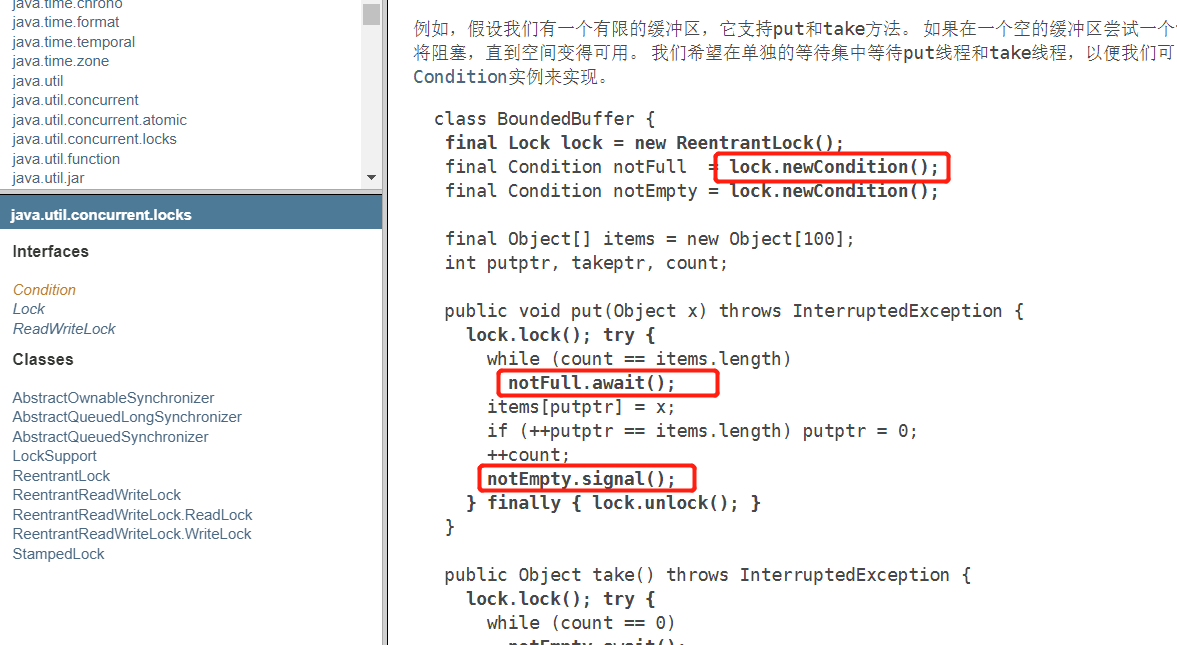
代码实现:
package com.zr.pc;
//生产者,消费者
import javax.activation.DataHandler;
import java.util.concurrent.locks.Condition;
import java.util.concurrent.locks.Lock;
import java.util.concurrent.locks.ReentrantLock;
/**
* 线程之间的通信问题,生产者消费者问题,等待唤醒,通知唤醒
* 线程A,B操作同一个变量
*/
public class Test2 {
public static void main(String[] args) {
Data2 data = new Data2();
new Thread(()->{
for (int i = 0; i < 10; i++) {
try {
data.increment();
} catch (InterruptedException e) {
e.printStackTrace();
}
}
},"A").start();
new Thread(()->{
for (int i = 0; i < 10; i++) {
try {
data.decrement();
} catch (InterruptedException e) {
e.printStackTrace();
}
}
},"B").start();
new Thread(()->{
for (int i = 0; i < 10; i++) {
try {
data.increment();
} catch (InterruptedException e) {
e.printStackTrace();
}
}
},"C").start();
new Thread(()->{
for (int i = 0; i < 10; i++) {
try {
data.decrement();
} catch (InterruptedException e) {
e.printStackTrace();
}
}
},"D").start();
}
}
class Data2{
private int number = 0;
Lock lock = new ReentrantLock();
Condition condition = lock.newCondition();
//condition.await(); //等待
//condition.signalAll(); //唤醒全部
//+1
public void increment() throws InterruptedException {
lock.lock();
try {
while (number!=0){
condition.await(); //等待
}
number++;
System.out.println(Thread.currentThread().getName()+"===>"+number);
condition.signalAll(); //通知
} catch (Exception e) {
e.printStackTrace();
} finally {
lock.unlock();
}
}
//-1
public void decrement() throws InterruptedException {
lock.lock();
try {
while (number==0){
condition.await(); //等待
}
number--;
System.out.println(Thread.currentThread().getName()+"===>"+number);
condition.signalAll(); //通知
} catch (Exception e) {
e.printStackTrace();
} finally {
lock.unlock();
}
}
}
结果是随机的状态:

此时Condition的作用就体现出来了,可以精准的通知和唤醒线程。
测试:
package com.zr.pc;
import java.util.concurrent.locks.Condition;
import java.util.concurrent.locks.Lock;
import java.util.concurrent.locks.ReentrantLock;
/**
* @author Zhour 813794474@qq.com
* A调B,B调C,C调A
*/
public class Test3 {
public static void main(String[] args) {
Data3 data = new Data3();
new Thread(()->{
for (int i = 0; i < 10; i++) {
data.printA();
}
},"A").start();
new Thread(()->{
for (int i = 0; i < 10; i++) {
data.printB();
}
},"B").start();
new Thread(()->{
for (int i = 0; i < 10; i++) {
data.printC();
}
},"C").start();
}
}
class Data3{ //资源类 lock
private Lock lock = new ReentrantLock();
Condition condition1 = lock.newCondition();
Condition condition2 = lock.newCondition();
Condition condition3 = lock.newCondition();
int num = 1;
public void printA(){
lock.lock();
try {
//业务
while (num!=1){
condition1.await();
}
System.out.println(Thread.currentThread().getName() + "==>AAAAA");
num = 2;
condition2.signal();
} catch (Exception e) {
e.printStackTrace();
} finally {
lock.unlock();
}
}
public void printB(){
lock.lock();
try {
//业务
while (num!=2){
condition2.await();
}
System.out.println(Thread.currentThread().getName()+"==>BBBBB");
num = 3;
condition3.signal();
} catch (Exception e) {
e.printStackTrace();
} finally {
lock.unlock();
}
}
public void printC(){
lock.lock();
try {
//业务
while (num!=3){
condition3.await();
}
System.out.println(Thread.currentThread().getName()+"==>CCCCC");
num = 1;
condition1.signal();
} catch (Exception e) {
e.printStackTrace();
} finally {
lock.unlock();
}
}
}
测试结果:

八锁现象
如何判断锁的是谁。
package com.zr.lock8;
import java.util.concurrent.TimeUnit;
public class Test1 {
public static void main(String[] args) throws InterruptedException {
Phone phone = new Phone();
new Thread(()->{
phone.sendMassage();
},"A").start();
TimeUnit.SECONDS.sleep(1);
new Thread(()->{
phone.call();
},"B").start();
}
}
class Phone{
//synchronized 锁的对象是方法的调用者
//两个方法是一把锁,谁先拿到谁先执行
public synchronized void sendMassage(){
System.out.println("发短信");
}
public synchronized void call(){
System.out.println("打电话");
}
}
package com.zr.lock8;
import java.util.concurrent.TimeUnit;
/**
*没有锁的方法不受影响
*/
public class Test2 {
public static void main(String[] args) throws InterruptedException {
//现在有两把锁
Phone2 phone = new Phone2();
Phone2 phone1 = new Phone2();
new Thread(()->{
phone.sendMassage();
},"A").start();
TimeUnit.SECONDS.sleep(1);
new Thread(()->{
phone1.call();
},"B").start();
new Thread(()->{
phone.hello();
},"B").start();
}
}
class Phone2{
//synchronized 锁的对象是方法的调用者
//两个方法是一把锁,谁先拿到谁先执行
public synchronized void sendMassage(){
try {
TimeUnit.SECONDS.sleep(3);
} catch (InterruptedException e) {
e.printStackTrace();
}
System.out.println("发短信");
}
public synchronized void call(){
System.out.println("打电话");
}
//这里没有锁,不受锁的影响
public void hello(){
System.out.println("hello");
}
}
package com.zr.lock8;
import java.util.concurrent.TimeUnit;
/**
* 静态的同步方法,锁的是phone.class!!!
*/
public class Test3 {
public static void main(String[] args) throws InterruptedException {
//两个对象的class类模板只有一个,两个锁都是锁的class
Phone3 phone = new Phone3();
Phone3 phone1 = new Phone3();
new Thread(()->{
phone.sendMassage();
},"A").start();
TimeUnit.SECONDS.sleep(1);
new Thread(()->{
phone1.call();
},"B").start();
}
}
class Phone3{
//synchronized 锁的对象是方法的调用者
//两个方法是一把锁,谁先拿到谁先执行
//static 类一加载就有了 锁的是class
public static synchronized void sendMassage(){
try {
TimeUnit.SECONDS.sleep(3);
} catch (InterruptedException e) {
e.printStackTrace();
}
System.out.println("发短信");
}
public static synchronized void call(){
System.out.println("打电话");
}
}
package com.zr.lock8;
import java.util.concurrent.TimeUnit;
/**
* 一个静态同步方法,一个普通同步方法
*/
public class Test4 {
public static void main(String[] args) throws InterruptedException {
Phone4 phone = new Phone4();
new Thread(()->{
phone.sendMassage();
},"A").start();
TimeUnit.SECONDS.sleep(1);
new Thread(()->{
phone.call();
},"B").start();
}
}
class Phone4{
//synchronized 锁的对象是方法的调用者
//两个方法是一把锁,谁先拿到谁先执行
//static 类一加载就有了 锁的是class
//静态同步方法 锁class类模板
public static synchronized void sendMassage(){
try {
TimeUnit.SECONDS.sleep(3);
} catch (InterruptedException e) {
e.printStackTrace();
}
System.out.println("发短信");
}
//普通同步方法 锁的是调用者
public synchronized void call(){
System.out.println("打电话");
}
}
小结
new this 具体的一个实例
static class 唯一的一个模板
不安全集合
ArrayList多线程下 add 方法不安全。
CopyOnWriteArrayList(安全)
package com.zr.unsafe;
import java.util.*;
import java.util.concurrent.CopyOnWriteArrayList;
//java.util.ConcurrentModificationException 使用ArrayList并发修改异常
public class ListTest {
public static void main(String[] args) {
//并发下ArrayList是不安全的
/**
* 解决方案
* 1.List<String> arrayList = new Vector(); 底层synchronized
* 2.List<String> arrayList = Collections.synchronizedList(new ArrayList<>());
* 3.List<String> arrayList = new CopyOnWriteArrayList();
*/
//CopyOnWrite 写入并复制 底层 lock
List<String> arrayList = new CopyOnWriteArrayList();
for (int i = 1; i <= 10; i++) {
new Thread(()->{
arrayList.add(UUID.randomUUID().toString().substring(0,5));
System.out.println(arrayList);
},String.valueOf(i)).start();
}
}
}
HashSet不安全。
CopyOnWriteArraySet(安全)
package com.zr.unsafe;
import java.util.Collections;
import java.util.HashSet;
import java.util.Set;
import java.util.UUID;
import java.util.concurrent.CopyOnWriteArraySet;
public class SetTest {
public static void main(String[] args) {
// Set<String> set = new HashSet(); 不安全
// 解决
//1.Set set = Collections.synchronizedSet(new HashSet());
//2. Set set = new CopyOnWriteArraySet();
Set set = new CopyOnWriteArraySet();
for (int i = 0; i < 20; i++) {
new Thread(()->{
set.add(UUID.randomUUID().toString().substring(0,5));
System.out.println(Thread.currentThread().getName()+set);
},String.valueOf(i)).start();
}
}
}
HashSet底层,就是HashMap
public HashSet() {
map = new HashMap<>();
}
//add key是无法重复的
public boolean add(E e) {
return map.put(e, PRESENT)==null;
}
private static final Object PRESENT = new Object(); //常量
HashMap不安全。
回顾map
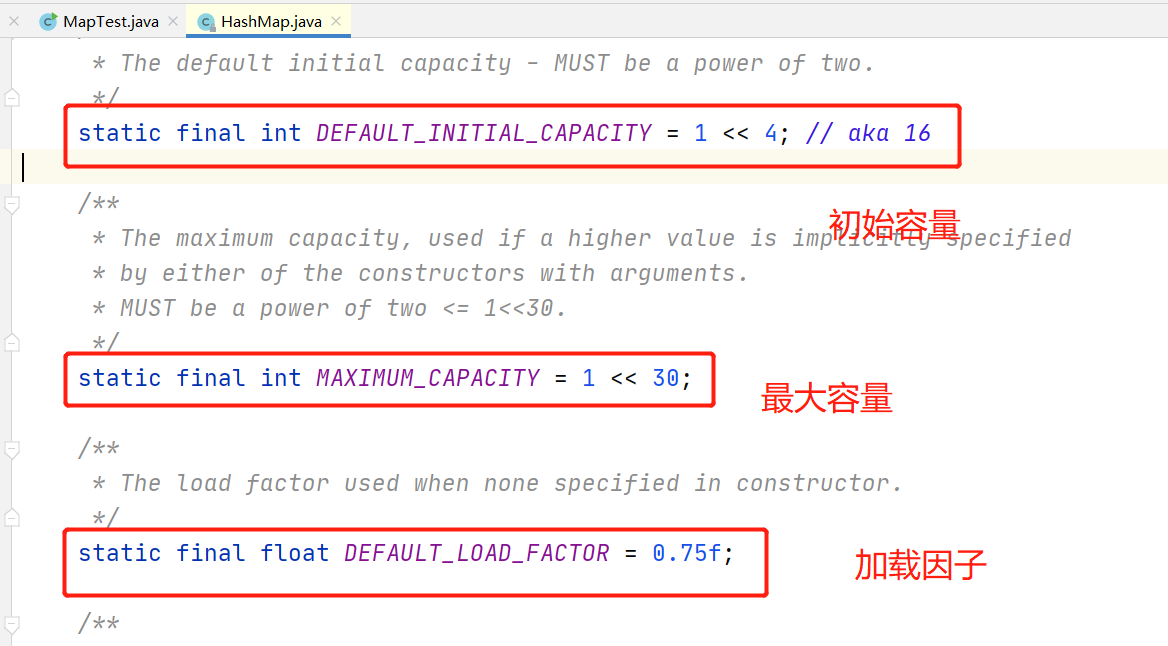
实现:
package com.zr.unsafe;
import java.util.HashMap;
import java.util.Map;
import java.util.UUID;
import java.util.concurrent.ConcurrentHashMap;
public class MapTest {
public static void main(String[] args) {
//Map<String,Object> map = new HashMap(); 不安全
//解决线程不安全
Map<String,Object> map = new ConcurrentHashMap();
for (int i = 0; i < 20; i++) {
new Thread(()->{
map.put(Thread.currentThread().getName(), UUID.randomUUID().toString().substring(0,5));
System.out.println(map);
},String.valueOf(i)).start();
}
}
}
Callable

- 可以有返回值
- 可以抛出异常
- 方法不同,call()
Runable

FutureTask

package com.zr.callable;
import java.util.concurrent.Callable;
import java.util.concurrent.ExecutionException;
import java.util.concurrent.FutureTask;
public class CallableTest {
public static void main(String[] args) throws ExecutionException, InterruptedException {
//new Thread().start(); 怎么启动callable
myThread myThread = new myThread();
FutureTask futureTask = new FutureTask(myThread);
new Thread(futureTask,"A").start();
new Thread(futureTask,"B").start(); //结果会被缓存
//获取callable的返回结果
String o = (String) futureTask.get(); //这个get方法可能会产生阻塞 放到最后一行或者使用异步通信
System.out.println(o);
}
}
class myThread implements Callable<String> {
@Override
public String call(){
System.out.println("call");
//如果是耗时的操作
return "123";
}
}
注意:
- 有缓存
- 结果可能需要等待,会阻塞
常用的辅助类(必会)
CountDownLatch

测试代码
package com.zr.add;
import java.util.concurrent.CountDownLatch;
//计数器
public class CountDownLatchDemo {
public static void main(String[] args) throws InterruptedException {
//总数是 6 有必须要执行完的任务时使用
CountDownLatch countDownLatch = new CountDownLatch(5);
for (int i = 1; i <=5; i++) {
new Thread(()->{
System.out.println(Thread.currentThread().getName()+"go out");
countDownLatch.countDown(); //计数器减一
},String.valueOf(i)).start();
}
countDownLatch.await(); //等待计数器归0,再向下执行
System.out.println("clsoe");
}
}
原理:
countDownLatch.countDown():数量减一
countDownLatch.await():直到计数器归0后,才向下执行
CyclicBarrier

测试代码:(可以想象成加法计数器)
package com.zr.add;
import java.util.concurrent.BrokenBarrierException;
import java.util.concurrent.CyclicBarrier;
public class CyclicBarrierDemo {
public static void main(String[] args) {
CyclicBarrier cyclicBarrier = new CyclicBarrier(7,()->{
System.out.println("集齐七个了");
});
for (int i = 1; i <= 7; i++) {
final int temp = i;
new Thread(()->{
System.out.println(Thread.currentThread().getName()+"第"+temp+"个");
try {
cyclicBarrier.await(); //等待
} catch (InterruptedException e) {
e.printStackTrace();
} catch (BrokenBarrierException e) {
e.printStackTrace();
}
}).start();
}
}
}
Semaphore
信号量

测试代码
package com.zr.add;
import java.util.concurrent.Semaphore;
import java.util.concurrent.TimeUnit;
public class SemaphoreDemo {
public static void main(String[] args) {
//停车位 限流
Semaphore semaphore = new Semaphore(3);
for (int i = 1; i <= 6; i++) {
new Thread(()->{
try {
semaphore.acquire(); //获取
System.out.println(Thread.currentThread().getName()+"抢到车位");
TimeUnit.SECONDS.sleep(2);
System.out.println(Thread.currentThread().getName()+"离开车位");
} catch (InterruptedException e) {
e.printStackTrace();
}finally {
semaphore.release(); //释放
}
},String.valueOf(i)).start();
}
}
}
原理:
semaphore.acquire(); 获取,假如满了,就等待释放后再执行。
semaphore.release(); 释放,将得到的信号量释放。
共享资源互斥的时候使用,并发限流,控制最大线程数。
读写锁

测试代码
package com.zr.rw;
import java.util.HashMap;
import java.util.Map;
import java.util.concurrent.locks.Lock;
import java.util.concurrent.locks.ReadWriteLock;
import java.util.concurrent.locks.ReentrantLock;
import java.util.concurrent.locks.ReentrantReadWriteLock;
/**
* ReadWriteLock
* 独占锁(写锁)一次只能被一个线程占有
* 共享锁(读锁)多个线程可以同时占有
*/
public class ReadWriteLockDemo {
public static void main(String[] args) {
MyCacheLock myCache = new MyCacheLock();
//写入
for (int i = 0; i < 5; i++) {
final int temp = i;
new Thread(()->{
myCache.put(temp+"",temp+"");
},String.valueOf(i)).start();
}
//读取
for (int i = 0; i < 5; i++) {
final int temp = i;
new Thread(()->{
myCache.get(temp+"");
},String.valueOf(i)).start();
}
}
}
//加锁
class MyCacheLock{
private volatile Map<String,Object> map = new HashMap<>();
//读写锁 更加细粒度的控制
private ReadWriteLock readWriteLock = new ReentrantReadWriteLock();
//存
public void put(String key,Object value){
readWriteLock.writeLock().lock();
try {
System.out.println(Thread.currentThread().getName()+"写入"+key);
map.put(key,value);
System.out.println(Thread.currentThread().getName()+"写入ok");
} catch (Exception e) {
e.printStackTrace();
} finally {
readWriteLock.writeLock().unlock();
}
}
//取
public void get(String key){
readWriteLock.readLock().lock();
try {
System.out.println(Thread.currentThread().getName()+"读取"+key);
Object o = map.get(key);
System.out.println(Thread.currentThread().getName()+"读取的key是"+o);
} catch (Exception e) {
e.printStackTrace();
} finally {
readWriteLock.readLock().unlock();
}
}
}
/**
* 自定义缓存
*/
class MyCache{
private volatile Map<String,Object> map = new HashMap<>();
//存
public void put(String key,Object value){
System.out.println(Thread.currentThread().getName()+"写入"+key);
map.put(key,value);
System.out.println(Thread.currentThread().getName()+"写入ok");
}
//取
public void get(String key){
System.out.println(Thread.currentThread().getName()+"读取"+key);
Object o = map.get(key);
System.out.println(Thread.currentThread().getName()+"读取的key是"+o);
}
}
阻塞队列
BlockingQueue

阻塞队列:多线程并发处理,线程池。
四组API
| 方式 | 抛出异常 | 不抛出异常,有返回值 | 阻塞等待 | 超时等待 |
|---|---|---|---|---|
| 添加 | add | offer | put | offer |
| 移除 | remove | poll | take | poll |
| 判断队列首 | element | peek |
测试一:
package com.zr.queue;
import java.util.Collections;
import java.util.concurrent.ArrayBlockingQueue;
public class Test {
public static void main(String[] args) {
test1();
}
/**
* 抛出异常
*/
public static void test1(){
//队列的大小
ArrayBlockingQueue<Object> queue = new ArrayBlockingQueue<>(3);
System.out.println(queue.add("a"));
System.out.println(queue.add("b"));
System.out.println(queue.add("c"));
System.out.println(queue.element()); //队首元素
//抛出异常 java.lang.IllegalStateException: Queue full
//System.out.println(queue.add("c"));
System.out.println(queue.remove()); //FIFO
System.out.println(queue.remove());
System.out.println(queue.remove());
}
}
测试二:
/**
* 不怕抛出异常 有返回值
*/
public static void test2(){
ArrayBlockingQueue<Object> queue = new ArrayBlockingQueue<>(3);
System.out.println(queue.offer("a"));
System.out.println(queue.offer("b"));
System.out.println(queue.offer("c"));
System.out.println(queue.offer("d")); //返回布尔值 不抛异常
System.out.println(queue.peek()); //队首元素
System.out.println("===============");
System.out.println(queue.poll());
System.out.println(queue.poll());
System.out.println(queue.poll());
System.out.println(queue.poll()); //返回null 不抛出异常
}
测试三:
/**
* 等待,阻塞(一直阻塞)
*/
public static void test3() throws InterruptedException {
//队列的大小
ArrayBlockingQueue<Object> queue = new ArrayBlockingQueue<>(3);
queue.put("a");
queue.put("b");
queue.put("c");
//queue.put("d"); //队列没有位置了 会一直阻塞
System.out.println(queue.take());
System.out.println(queue.take());
System.out.println(queue.take());
// System.out.println(queue.take()); //没有这个元素 也会一直阻塞
}
测试四:
/**
*等待超时(过时不候)
*/
public static void test4() throws InterruptedException {
//队列的大小
ArrayBlockingQueue<Object> queue = new ArrayBlockingQueue<>(3);
System.out.println(queue.offer("a"));
System.out.println(queue.offer("b"));
System.out.println(queue.offer("c"));
System.out.println(queue.offer("d",2, TimeUnit.SECONDS)); //超时退出
System.out.println("==========");
System.out.println(queue.poll());
System.out.println(queue.poll());
System.out.println(queue.poll());
System.out.println(queue.poll(2,TimeUnit.SECONDS));
}
SynchronousQueue
同步队列,没有容量,进去一个元素必须取出来,才能再放一个元素。
package com.zr.queue;
import java.util.concurrent.SynchronousQueue;
import java.util.concurrent.TimeUnit;
/**
* 同步队列
* SynchronousQueue不存储元素 put进去一个值 必须toke出来 才能在put
*/
public class SynchronousQueueDemo {
public static void main(String[] args) {
SynchronousQueue<String> blockingQueue = new SynchronousQueue<>();
new Thread(()->{
try {
System.out.println(Thread.currentThread().getName()+"put 1");
blockingQueue.put("1");
System.out.println(Thread.currentThread().getName()+"put 2");
blockingQueue.put("2");
System.out.println(Thread.currentThread().getName()+"put 3");
blockingQueue.put("3");
} catch (InterruptedException e) {
e.printStackTrace();
}
},"T1").start();
new Thread(()->{
try {
TimeUnit.SECONDS.sleep(3);
System.out.println(Thread.currentThread().getName()+"-->"+blockingQueue.take());
TimeUnit.SECONDS.sleep(3);
System.out.println(Thread.currentThread().getName()+"-->"+blockingQueue.take());
TimeUnit.SECONDS.sleep(3);
System.out.println(Thread.currentThread().getName()+"-->"+blockingQueue.take());
} catch (InterruptedException e) {
e.printStackTrace();
}
},"T2").start();
}
}
线程池(重点)
池化技术!
程序的运行,本质会占用系统的资源!优化资源的使用,统一管理分配--->池化技术 !
线程池,连接池,内存池,对象池....
线程池的好处:
- 降低资源的消耗
- 提高响应的速度,创建和销毁十分浪费资源
- 方便统一管理
线程可以复用,控制最大并发数,统一管理!
线程池:三大方法,七大参数,四种拒绝策略!(可参考阿里巴巴开发手册)
测试代码
package com.zr.pool;
import java.util.concurrent.ExecutorService;
import java.util.concurrent.Executors;
/**
*Executors 工具类 三大方法、
*/
public class Demo01 {
public static void main(String[] args) {
ExecutorService threadPool = Executors.newSingleThreadExecutor();//单个线程
// Executors.newFixedThreadPool(5); //固定的大小
//Executors.newCachedThreadPool(); //可伸缩的
try {
for (int i = 0; i < 10; i++) {
//使用了线程池之后要使用线程池来创建线程
threadPool.execute(()->{
System.out.println(Thread.currentThread().getName()+":ok!");
});
}
} catch (Exception e) {
e.printStackTrace();
} finally {
//线程池使用完后要关机
threadPool.shutdown();
}
}
}
七大参数
源码分析
public static ExecutorService newSingleThreadExecutor() {
return new FinalizableDelegatedExecutorService
(new ThreadPoolExecutor(1, 1,
0L, TimeUnit.MILLISECONDS,
new LinkedBlockingQueue<Runnable>()));
}
public static ExecutorService newFixedThreadPool(int nThreads) {
return new ThreadPoolExecutor(nThreads, nThreads,
0L, TimeUnit.MILLISECONDS,
new LinkedBlockingQueue<Runnable>());
}
public static ExecutorService newCachedThreadPool() {
return new ThreadPoolExecutor(0, Integer.MAX_VALUE,
60L, TimeUnit.SECONDS,
new SynchronousQueue<Runnable>());
}
本质:ThreadPoolExecutor
public ThreadPoolExecutor(int corePoolSize, //核心线程池大小
int maximumPoolSize, //最大核心线程池的大小
long keepAliveTime, //最大存活时间(超时未调用释放)
TimeUnit unit, //超时单位
BlockingQueue<Runnable> workQueue, //阻塞队列
ThreadFactory threadFactory, //线程工厂,一般不用动
RejectedExecutionHandler handler //拒绝策略) {
if (corePoolSize < 0 ||
maximumPoolSize <= 0 ||
maximumPoolSize < corePoolSize ||
keepAliveTime < 0)
throw new IllegalArgumentException();
if (workQueue == null || threadFactory == null || handler == null)
throw new NullPointerException();
this.acc = System.getSecurityManager() == null ?
null :
AccessController.getContext();
this.corePoolSize = corePoolSize;
this.maximumPoolSize = maximumPoolSize;
this.workQueue = workQueue;
this.keepAliveTime = unit.toNanos(keepAliveTime);
this.threadFactory = threadFactory;
this.handler = handler;
}
四种拒绝策略

手动创建线程池
package com.zr.pool;
import java.util.concurrent.Executors;
import java.util.concurrent.LinkedBlockingQueue;
import java.util.concurrent.ThreadPoolExecutor;
import java.util.concurrent.TimeUnit;
/**
* new ThreadPoolExecutor.AbortPolicy() //不处理,队列满了 抛出异常
* new ThreadPoolExecutor.CallerRunsPolicy() //main线程执行
* new ThreadPoolExecutor.DiscardPolicy() //队列满了 丢掉任务 不会抛出异常
* new ThreadPoolExecutor.DiscardOldestPolicy()); //将最老的任务丢弃,尝试提交新的任务,不会跑异常
*/
public class Demo02 {
//自定义创建线程池
public static void main(String[] args) {
ThreadPoolExecutor threadPool = new ThreadPoolExecutor(
2,
5,
3,
TimeUnit.SECONDS,
new LinkedBlockingQueue<>(3),
Executors.defaultThreadFactory(),
new ThreadPoolExecutor.CallerRunsPolicy()); //将最老的任务丢弃,尝试提交新的任务,不会跑异常
try {
//最大承载 queue+max
// 超出最大承载 使用拒绝处理
for (int i = 0; i < 10; i++) {
//使用了线程池之后要使用线程池来创建线程
threadPool.execute(()->{
System.out.println(Thread.currentThread().getName()+":ok!");
});
}
} catch (Exception e) {
e.printStackTrace();
} finally {
//线程池使用完后要关机
threadPool.shutdown();
}
}
}
最大线程该如何设置
CPU密集型:计算量大的,线程数量可设置为电脑核心数+1,Runtime.getRuntime().availableProcessors()获取电脑核心数。
IO密集型:读写操作非常多的,线程数量可设置为电脑核心数*2。
四大函数式接口
现在必须掌握的:lambda表达式,链式编程,函数式接口,Stream流式计算。
函数式接口:只有一个方法的接口。
@FunctionalInterface
public interface Runnable {
public abstract void run();
}
//很多@FunctionalInterface
//简化编程模型,新版本的框架底层大量应用
//foreach(消费者类型的函数式接口)
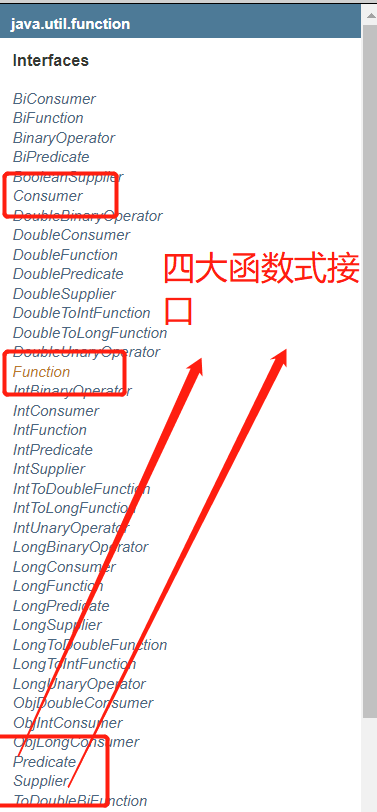
测试代码:Function
package com.zr.function;
import java.util.function.Function;
/**
* function 函数型接口
* 有一个输入参数,有一个输出
* 只要是函数式接口,可以用lambda表达式简化
*/
public class Demo01 {
public static void main(String[] args) {
//工具类 输出出入的值
// Function function = new Function<String,String>() {
// @Override
// public String apply(String str) {
// return str;
// }
// };
Function<String,String> function = (str)->{return str;};
System.out.println(function.apply("123"));
}
}
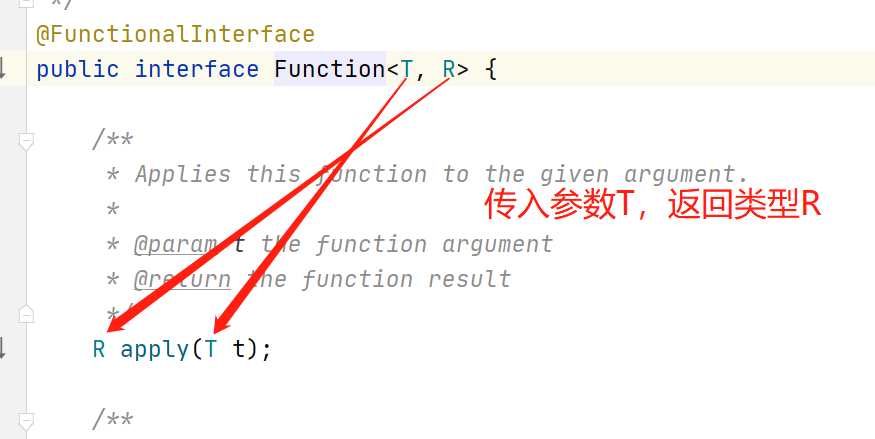
测试代码:断定型接口 Predicate
package com.zr.function;
import java.util.function.Predicate;
/**
* 断定型接口,有一个输入值,返回值是 布尔值
*/
public class Demo02 {
public static void main(String[] args) {
//判断字符串是否为空
// Predicate<String> predicate = new Predicate<String>() {
// @Override
// public boolean test(String str) {
// return str.isEmpty();
// }
// };
Predicate<String> predicate = (str)->{return str.isEmpty();}; //(str)的()可以省略
System.out.println(predicate.test("asdf"));
}
}
Consumer:消费型接口
测试代码:
package com.zr.function;
import java.util.function.Consumer;
/**
* 消费型接口 只有输入 没有返回值
*/
public class Demo03 {
public static void main(String[] args) {
// Consumer<String> consumer = new Consumer<String>() {
// @Override
// public void accept(String str) {
// System.out.println(str);
// }
// };
Consumer<String> consumer = (str)->{
System.out.println(str);
};
consumer.accept("abc");
}
}
Supplier:供给型接口
测试代码:
package com.zr.function;
import java.util.function.Supplier;
/**
* 供给型接口 只返回 不输入
*/
public class Demo04 {
public static void main(String[] args) {
// Supplier supplier = new Supplier<Integer>() {
// @Override
// public Integer get() {
// return 1024;
// }
// };
Supplier supplier = ()->{
return 1024;
};
System.out.println(supplier.get());
}
}
Stream流式计算
大数据:存储+计算
集合,数据库是来存储的。
计算都应该交给流来计算。
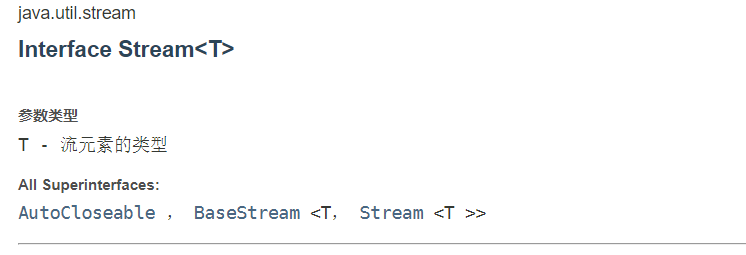
测试代码:User
package com.zr.stream;
import lombok.AllArgsConstructor;
import lombok.Data;
import lombok.NoArgsConstructor;
@Data
@NoArgsConstructor
@AllArgsConstructor
public class User {
private int id;
private String name;
private int age;
}
Test
package com.zr.stream;
import java.util.ArrayList;
import java.util.Arrays;
import java.util.List;
/**
* 一行代码实现,现有五个用户,筛选
* 1.id是偶数的
* 2.年龄大于22
* 3.用户名转化为大写字母
* 4.用户名字母倒着排序
* 5.只输出一个用户
*/
public class Test {
public static void main(String[] args) {
User u1 = new User(1,"a",20);
User u2 = new User(2,"b",21);
User u3 = new User(3,"c",22);
User u4 = new User(4,"d",23);
User u5 = new User(6,"e",24);
//转化为list
List<User> list = Arrays.asList(u1, u2, u3, u4, u5);
//计算交给流处理
// lambda表达式,链式编程,函数式接口,Stream流式计算
list.stream()
.filter(u->{return u.getId()%2==0;})
.filter(u->{return u.getAge()>22;})
.map(u->{return u.getName().toUpperCase();})
.sorted((uu1,uu2)->{return uu2.compareTo(uu1);})
.limit(1)
.forEach(System.out::println);
}
}
ForkJoin
分支合并
在1.7之后出来的,并行执行任务,提高效率的!大数据量的。
ForkJoin的特点:工作窃取。
维护的是双端队列,A线程任务执行完后会把B线程还未执行完的任务拿过来一部分执行。
ForkJoin操作:ForkJoinPool 通过它来执行

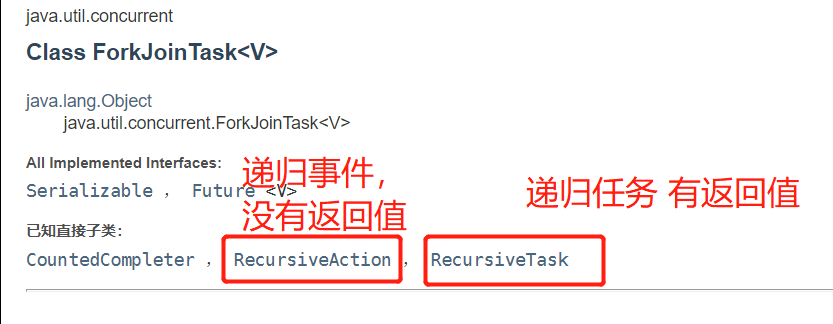
测试代码:
package com.zr.forkjoin;
import java.util.concurrent.RecursiveTask;
/**
* 求和计算的任务
* 使用 ForkJoinPool 来执行
* 计算任务 forkJoinPool.execute(forkJoinTask task)
*/
public class ForkJoinDemo extends RecursiveTask<Long> {
private long start;
private long end;
//临界值
private long temp = 100000L;
public ForkJoinDemo(long start, long end) {
this.start = start;
this.end = end;
}
//计算方法
@Override
protected Long compute() {
long sum = 0;
if ((end-start)<temp){
for (long i = start; i < end; i++) {
sum += i;
}
return sum;
}else { //forkjoin
long mid = (start+end)/2; //中间值
ForkJoinDemo task1 = new ForkJoinDemo(start, mid);
task1.fork(); //拆分任务,把线程压入线程队列
ForkJoinDemo task2 = new ForkJoinDemo(mid+1, end);
task2.fork();
return task1.join() + task2.join();
}
}
}
test
package com.zr.forkjoin;
import java.util.concurrent.ExecutionException;
import java.util.concurrent.ForkJoinPool;
import java.util.concurrent.ForkJoinTask;
import java.util.stream.LongStream;
public class Test {
public static void main(String[] args) throws ExecutionException, InterruptedException {
//test1();
//test2();
test3();
}
public static void test1(){
long sum = 0;
long start = System.currentTimeMillis();
for (long i = 0; i < 10_0000_0000; i++) {
sum+=i;
}
long end = System.currentTimeMillis();
System.out.println("sum="+sum+"时间:"+(end-start));
}
//forkjoin
public static void test2() throws ExecutionException, InterruptedException {
long start = System.currentTimeMillis();
ForkJoinPool forkJoinPool = new ForkJoinPool();
ForkJoinDemo task = new ForkJoinDemo(0, 10_0000_0000);
ForkJoinTask<Long> submit = forkJoinPool.submit(task);
Long sum = submit.get();
long end = System.currentTimeMillis();
System.out.println("sum="+sum+"时间:"+(end-start));
}
//流计算
public static void test3(){
long start = System.currentTimeMillis();
long sum = LongStream.rangeClosed(0, 10_0000_0000).parallel().reduce(0, Long::sum);
long end = System.currentTimeMillis();
System.out.println("sum="+"时间:"+(end-start));
}
}
异步回调
Future设计的初衷,是对将来某个时间的结果建模。
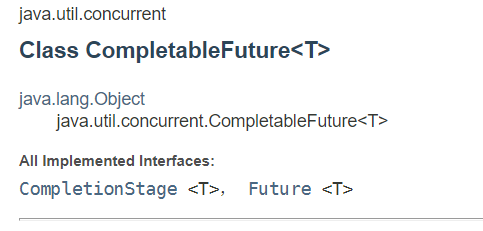
测试代码:
package com.zr.future;
import java.util.concurrent.CompletableFuture;
import java.util.concurrent.ExecutionException;
import java.util.concurrent.TimeUnit;
/**
* 异步调用 CompletableFuture
* 异步执行
* 成功回调
* 失败回调
*/
public class Demo01 {
public static void main(String[] args) throws ExecutionException, InterruptedException {
//没有返回值的异步回调
// CompletableFuture<Void> future = CompletableFuture.runAsync(()->{
// try {
// TimeUnit.SECONDS.sleep(2);
// } catch (InterruptedException e) {
// e.printStackTrace();
// }
// System.out.println(Thread.currentThread().getName()+"runAsync==>Void");
// });
// System.out.println("111");
// future.get();
//有返回值的异步回调
CompletableFuture<Integer> future1 = CompletableFuture.supplyAsync(()->{
System.out.println(Thread.currentThread().getName()+"supplyAsync==>Integer");
//int i = 10/0;
return 1024;
});
System.out.println(future1.whenComplete((t,u)->{
System.out.println("t=>"+t+"; u=>"+u); //t 正常的返回结果 u 错误的信息
}).exceptionally((e)->{
System.out.println(e.getMessage());
return 233;
}).get());
}
}
JMM
Volatile是Java虚拟机的轻量级同步机制。
- 保证可见性
- 不保证原子性
- 禁止指令重排
JMM:Java内存模型。不真实存在,概念,约定!
关于JMM的一些同步约定:
- 线程加锁前:必须把主存中变量最新值读取到工作内存中
- 线程解锁前:必须把共享变量立即同步到主存
- 加锁和解锁是同一把锁
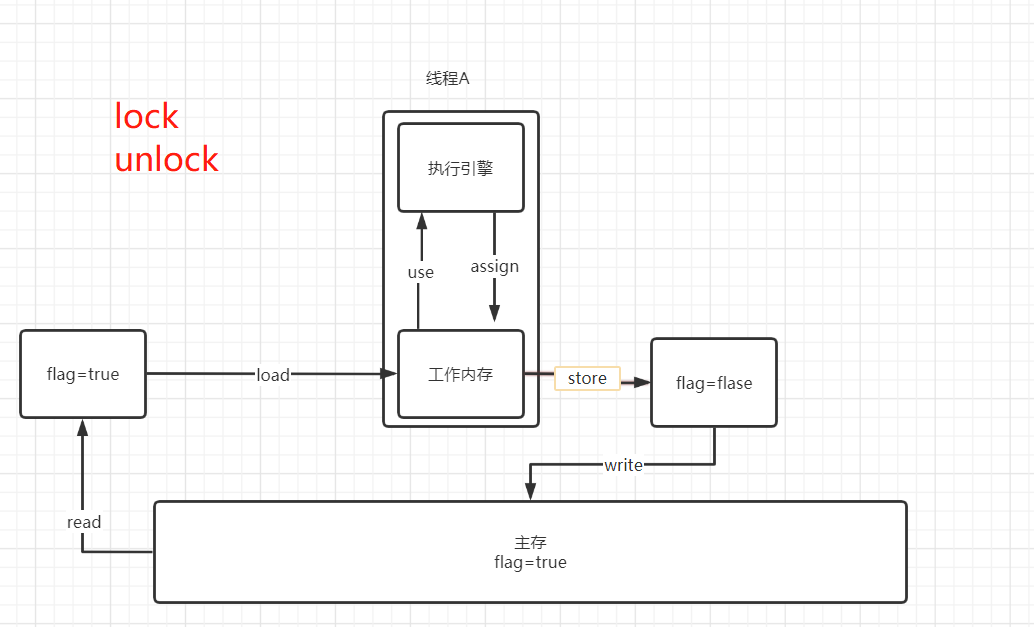
如果线程A修改了值,线程B还在使用之前读到的值,此时就需要引入Volatile!

内存交互操作有8种,虚拟机实现必须保证每一个操作都是原子的,不可在分的(对于double和long类型的变量来说,load、store、read和write操作在某些平台上允许例外)
-
- lock (锁定):作用于主内存的变量,把一个变量标识为线程独占状态
- unlock (解锁):作用于主内存的变量,它把一个处于锁定状态的变量释放出来,释放后的变量才可以被其他线程锁定
- read (读取):作用于主内存变量,它把一个变量的值从主内存传输到线程的工作内存中,以便随后的load动作使用
- load (载入):作用于工作内存的变量,它把read操作从主存中变量放入工作内存中
- use (使用):作用于工作内存中的变量,它把工作内存中的变量传输给执行引擎,每当虚拟机遇到一个需要使用到变量的值,就会使用到这个指令
- assign (赋值):作用于工作内存中的变量,它把一个从执行引擎中接受到的值放入工作内存的变量副本中
- store (存储):作用于主内存中的变量,它把一个从工作内存中一个变量的值传送到主内存中,以便后续的write使用
- write (写入):作用于主内存中的变量,它把store操作从工作内存中得到的变量的值放入主内存的变量中
JMM对这八种指令的使用,制定了如下规则:
-
- 不允许read和load、store和write操作之一单独出现。即使用了read必须load,使用了store必须write
- 不允许线程丢弃他最近的assign操作,即工作变量的数据改变了之后,必须告知主存
- 不允许一个线程将没有assign的数据从工作内存同步回主内存
- 一个新的变量必须在主内存中诞生,不允许工作内存直接使用一个未被初始化的变量。就是怼变量实施use、store操作之前,必须经过assign和load操作
- 一个变量同一时间只有一个线程能对其进行lock。多次lock后,必须执行相同次数的unlock才能解锁
- 如果对一个变量进行lock操作,会清空所有工作内存中此变量的值,在执行引擎使用这个变量前,必须重新load或assign操作初始化变量的值
- 如果一个变量没有被lock,就不能对其进行unlock操作。也不能unlock一个被其他线程锁住的变量
- 对一个变量进行unlock操作之前,必须把此变量同步回主内存
Volatile
保证可见性
package com.zr.testvolatile;
import java.sql.Time;
import java.util.concurrent.TimeUnit;
public class JMMDemo {
//未加volatile,while会死循环
private static volatile int num = 0;
public static void main(String[] args) throws InterruptedException { //main线程
new Thread(()->{ //未加volatile前,线程1对主内存的变化是不知道的
while (num == 0){
}
}).start();
TimeUnit.SECONDS.sleep(1);
num = 1;
System.out.println(num);
}
}
不保证原子性
原子性,不可分割
线程A在执行任务的时候是不能被打扰的,也不能变为分割,要么同时成功,要么同时失败。
package com.zr.testvolatile;
//不保证原子性
public class Demo02 {
//volatile不保证原子性
private volatile static int num = 0;
public static void main(String[] args) {
//理论上的值应该为20000
for (int i = 1; i <= 20; i++) {
new Thread(()->{
for (int j = 1; j <= 1000; j++) {
add();
}
}).start();
}
while (Thread.activeCount()>2){
Thread.yield();
}
System.out.println(num);
}
public static void add(){
num++;
}
}
如果不加 Lock 或者 Synchronized 怎么保证原子性。
cmd进入编译编译后的文件夹中,java -c Demo02.class可以查看字节码。可以看到num++不是原子性的操作。
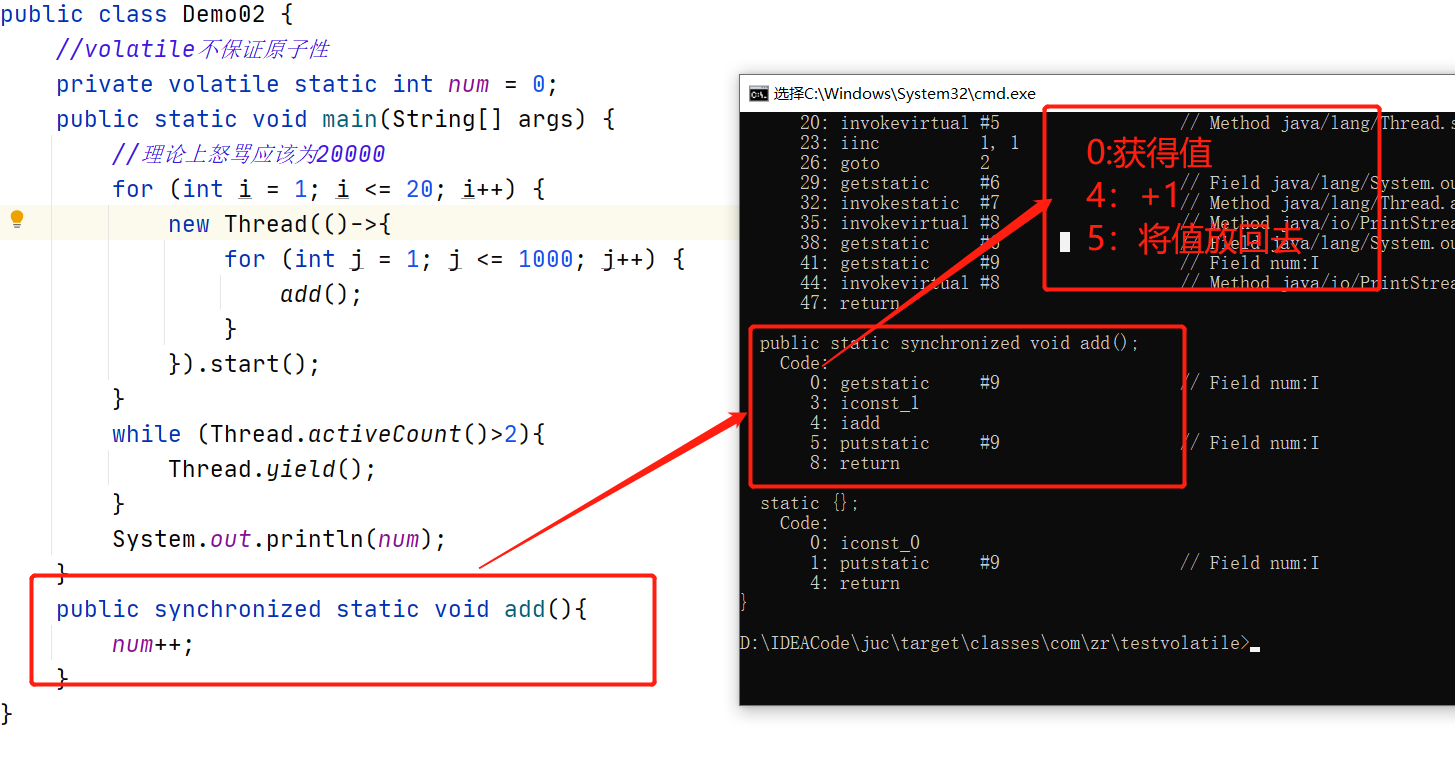
使用原子类,解决原子性问题。

测试代码:AtomicInteger
package com.zr.testvolatile;
import java.util.concurrent.atomic.AtomicInteger;
//不保证原子性
public class Demo03 {
//volatile不保证原子性
//原子类的
private volatile static AtomicInteger num = new AtomicInteger();
public static void main(String[] args) {
//理论上的值应该为20000
for (int i = 1; i <= 20; i++) {
new Thread(()->{
for (int j = 1; j <= 1000; j++) {
add();
}
}).start();
}
while (Thread.activeCount()>2){
Thread.yield();
}
System.out.println(num);
}
public synchronized static void add(){
num.getAndIncrement(); //AtomicInteger的加 1 方法 CAS
}
}
这些原子类的底层直接和操作系统挂钩!在内存中修改值。unsafe类是一个特殊的存在(CAS)!
指令重排:自己写的程序,计算机并不会按照程序写的顺序来执行。
源代码--->编译器优化重排--->指令并行也可能会重排--->内存系统也会重排--->执行
处理器在指令重排的时候会考虑数据之间的依赖性。
volatile可以避免指令重排:
内存屏障!cpu指令,作用:
- 保证特定操作的执行顺序
- 保证某些变量的内存可见性(volatile利用这个保证了可见性)
单例模式
饿汉式
package classes.com.zr.single;
//饿汉式单例
public class Hungry {
//构造器私有
private Hungry(){
}
private final static Hungry hungry = new Hungry();
public static Hungry getHangry(){
return hungry;
}
}
懒汉式 :DCL懒汉式
package classes.com.zr.single;
//懒汉式单例
public class Lazy01 {
private Lazy01(){
System.out.println(Thread.currentThread().getName()+"ok");
}
//volatile 防止创建对象时指令重排
private volatile static Lazy01 lazy01;
//不安全的单例
// public static Lazy01 getInstance(){
// if (lazy01==null){
// lazy01 = new Lazy01();
// }
// return lazy01;
//}
//双重检查锁 DCL 懒汉式单例
public static Lazy01 getInstance(){
if (lazy01==null){
synchronized (Lazy01.class){
if (lazy01==null){
lazy01 = new Lazy01(); //不是原子性操作
/**
* 1.分配内存空间
* 2.执行构造方法,初始化对象
* 3.把对象指向内存空间
*/
}
}
}
return lazy01;
}
public static void main(String[] args) {
new Thread(()->{
for (int i = 0; i < 10; i++) {
Lazy01.getInstance();
}
}).start();
}
}
使用反射破坏:
package classes.com.zr.single;
import java.lang.reflect.Constructor;
//懒汉式单例 反射破坏单例
public class Lazy02 {
private Lazy02(){
synchronized (Lazy02.class){
if (lazy02!=null){
throw new RuntimeException("不要使用反射来破坏单例");
}
}
}
//volatile 防止创建对象时指令重排
private volatile static Lazy02 lazy02;
//双重检查锁 检查 DCL 懒汉式单例
public static Lazy02 getInstance(){
if (lazy02==null){
synchronized (Lazy01.class){
if (lazy02==null){
lazy02 = new Lazy02(); //不是原子性操作
}
}
}
return lazy02;
}
public static void main(String[] args) throws Exception {
Lazy02 instance1 = Lazy02.getInstance();
Constructor<Lazy02> constructor = Lazy02.class.getDeclaredConstructor(null);
constructor.setAccessible(true); //可以访问
Lazy02 instance2 = constructor.newInstance(); //创建实例
System.out.println(instance1);
System.out.println(instance2);
}
}
静态内部类
package com.zr.single;
//静态内部类实现
public class Holder {
private Holder(){
}
public static Holder getInstance(){
return Test.HOLDER;
}
public static class Test{
private static final Holder HOLDER = new Holder();
}
}
枚举:反射无法破坏枚举
package com.zr.single;
import java.lang.reflect.Constructor;
//枚举 jdk 1.5 有的 本身也是一个类
public enum EnumSingle {
INSTANCE;
public EnumSingle getInstance(){
return INSTANCE;
}
}
class Test{
public static void main(String[] args) throws Exception {
EnumSingle instance1 = EnumSingle.INSTANCE;
//String.class,int.class 通过jad反编译看到构造方法是有参数的
Constructor<EnumSingle> declaredConstructor = EnumSingle.class.getDeclaredConstructor(String.class,int.class);
declaredConstructor.setAccessible(true);
EnumSingle instance2 = declaredConstructor.newInstance();
System.out.println(instance1.hashCode());
System.out.println(instance2.hashCode());
}
}

无法破坏枚举:

深入理解CAS
什么是cas:compareAndSet 比较并交换,如果期望的值达到了就更新,否则就不更新,CAS cpu的并发原语。
package com.zr.cas;
import java.util.concurrent.atomic.AtomicInteger;
public class CASDemo {
//CAS compareAndSet 比较并交换
public static void main(String[] args) {
AtomicInteger atomicInteger = new AtomicInteger(2021);
// public final boolean compareAndSet(int expect, int update)
//如果期望的值达到了就更新,否则就不更新,CAS cpu的并发原语
System.out.println(atomicInteger.compareAndSet(2021, 2022));
System.out.println(atomicInteger.get());
}
}
unsafe:
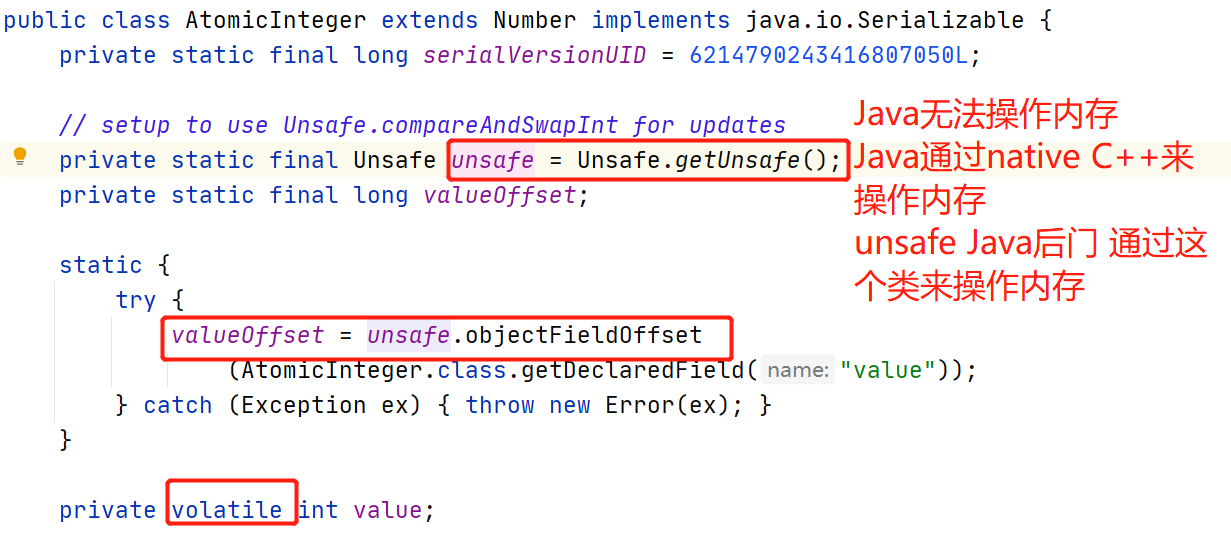
getAndIncrement:增加1

getAndAddInt:自旋锁

CAS缺点:自旋锁循环会耗时,一次只能保证一个共享变量的原子性,会导致ABA问题。
CAS:ABA问题,狸猫换太子。
A,B两个线程访问内存中的变量1,A拿到后将变量变为2,再把2变为1,此时B并不知道这个1是不是原来访问的那个1。
package com.zr.cas;
import java.util.concurrent.atomic.AtomicInteger;
public class ABADemo {
//CAS compareAndSet 比较并交换
public static void main(String[] args) {
AtomicInteger atomicInteger = new AtomicInteger(2021);
// public final boolean compareAndSet(int expect, int update)
//如果期望的值达到了就更新,否则就不更新,CAS cpu的并发原语
System.out.println(atomicInteger.compareAndSet(2021, 2022));
System.out.println(atomicInteger.get());
System.out.println(atomicInteger.compareAndSet(2022, 2021));
System.out.println(atomicInteger.get());
System.out.println(atomicInteger.compareAndSet(2021, 2022));
System.out.println(atomicInteger.get());
}
}
原子引用
解决ABA问题:引入原子引用,对应的思想,乐观锁!
带版本号的原子操作。
package com.zr.cas;
import java.util.concurrent.TimeUnit;
import java.util.concurrent.atomic.AtomicInteger;
import java.util.concurrent.atomic.AtomicStampedReference;
public class RefrenceDemo {
//注意,如果泛型是一个包装类,注意对象引用问题!!!
static AtomicStampedReference<Integer> atomicStampedReference = new AtomicStampedReference<>(1,1);
public static void main(String[] args) {
new Thread(()->{
int stamp = atomicStampedReference.getStamp(); //获得版本号
System.out.println("A线程拿到的是"+stamp);
try {
TimeUnit.SECONDS.sleep(2);
} catch (InterruptedException e) {
e.printStackTrace();
}
System.out.println(atomicStampedReference.compareAndSet(1, 2,
atomicStampedReference.getStamp(), atomicStampedReference.getStamp() + 1));
System.out.println("A2:"+atomicStampedReference.getStamp());
System.out.println(atomicStampedReference.compareAndSet(2, 1,
atomicStampedReference.getStamp(), atomicStampedReference.getStamp() + 1));
System.out.println("A3:"+atomicStampedReference.getStamp());
},"A").start();
new Thread(()->{
int stamp = atomicStampedReference.getStamp(); //获得版本号
System.out.println("B线程拿到的是"+stamp);
try {
TimeUnit.SECONDS.sleep(2);
} catch (InterruptedException e) {
e.printStackTrace();
}
System.out.println(atomicStampedReference.compareAndSet(1, 6,
stamp, stamp + 1));
System.out.println("B2:"+atomicStampedReference.getStamp());
},"B").start();
}
}
AtomicStampedReference
public AtomicStampedReference(V initialRef, int initialStamp) {
pair = Pair.of(initialRef, initialStamp);
}
因为 Integer 有缓存值,这里的 initialRef 测试应在-128到127之间,超过会在堆中重新创建对象,是个大坑!!
各种锁的理解
公平锁/非公平锁
公平锁:非常公平,不能插队,线程讲究先来先到。
非公平锁:非常不公平,可以插队,线程不讲究先来先到。
Synchronzied,ReentrantLock默认是非公平的。
public ReentrantLock() {
sync = new NonfairSync();
}
public ReentrantLock(boolean fair) {
sync = fair ? new FairSync() : new NonfairSync();
}
可重入锁
可重入锁(递归锁)
Synchronized
package com.zr.lock;
import java.awt.*;
//Synchronized
public class Demo01 {
public static void main(String[] args) {
Phone1 phone1 = new Phone1();
new Thread(()->{
phone1.sms();
},"A").start();
new Thread(()->{
phone1.sms();
},"B").start();
}
}
class Phone1{
public synchronized void sms(){
System.out.println(Thread.currentThread().getName()+"==>sms");
call();
}
public synchronized void call(){
System.out.println(Thread.currentThread().getName()+"==>call");
}
}
Lock
package com.zr.lock;
import java.util.concurrent.locks.Lock;
import java.util.concurrent.locks.ReentrantLock;
public class Demo02 {
public static void main(String[] args) {
Phone2 phone2 = new Phone2();
new Thread(()->{
phone2.sms();
},"A").start();
new Thread(()->{
phone2.sms();
},"B").start();
}
}
class Phone2{
Lock lock = new ReentrantLock();
public synchronized void sms(){
lock.lock(); //lock 加锁解锁必须成对出现
try {
System.out.println(Thread.currentThread().getName()+"==>sms");
call();
} catch (Exception e) {
e.printStackTrace();
} finally {
lock.unlock();
}
}
public synchronized void call(){
lock.lock();
try {
System.out.println(Thread.currentThread().getName()+"==>call");
} catch (Exception e) {
e.printStackTrace();
} finally {
lock.unlock();
}
}
}
自旋锁
Unsafe.getAndAddInt:这里就应用了自旋锁
public final int getAndAddInt(Object var1, long var2, int var4) {
int var5;
do {
var5 = this.getIntVolatile(var1, var2);
} while(!this.compareAndSwapInt(var1, var2, var5, var5 + var4));
return var5;
}
测试代码:利用CAS自己定义锁
package com.zr.lock;
import java.util.concurrent.atomic.AtomicReference;
//自旋锁
public class SpinLockDemo {
//Thread null
AtomicReference<Thread> atomicReference = new AtomicReference<>();
//加锁
public void myLock(){
Thread thread = Thread.currentThread();
System.out.println(Thread.currentThread().getName()+"==>myLock");
//自旋锁
while(!atomicReference.compareAndSet(null,thread)){
//System.out.println(Thread.currentThread().getName()+"自旋中...");
}
}
//解锁
public void myUnLock(){
Thread thread = Thread.currentThread();
System.out.println(Thread.currentThread().getName()+"==>myUnLock");
atomicReference.compareAndSet(thread,null);
}
}
测试:
package com.zr.lock;
import java.util.concurrent.TimeUnit;
public class TestSpinLock {
public static void main(String[] args) throws InterruptedException {
SpinLockDemo lock = new SpinLockDemo();
new Thread(()->{
lock.myLock();
try {
TimeUnit.SECONDS.sleep(3);
} catch (Exception e) {
e.printStackTrace();
} finally {
lock.myUnLock();
}
},"A").start();
TimeUnit.SECONDS.sleep(1);
new Thread(()->{
lock.myLock();
try {
} catch (Exception e) {
e.printStackTrace();
} finally {
lock.myUnLock();
}
},"B").start();
}
}
死锁
死锁:互斥,不可剥夺,请求保持,循环等待。
测试:
package com.zr.lock;
import java.util.concurrent.TimeUnit;
//模拟死锁
public class DeadLock {
public static void main(String[] args) {
String lockA = "lockA";
String lockB = "lockB";
new Thread(new myThread(lockA,lockB),"T1").start();
new Thread(new myThread(lockB,lockA),"T2").start();
}
}
class myThread implements Runnable{
private String lockA;
private String lockB;
public myThread(String lockA, String lockB) {
this.lockA = lockA;
this.lockB = lockB;
}
@Override
public void run() {
synchronized (lockA){
System.out.println(Thread.currentThread().getName()+"=lock:"+lockA+"==>get "+lockB);
try {
TimeUnit.SECONDS.sleep(2);
} catch (InterruptedException e) {
e.printStackTrace();
}
synchronized (lockB){
System.out.println(Thread.currentThread().getName()+"=lock:"+lockB+"==>get "+lockA);
}
}
}
}
解决问题
-
使用 jps -l 定位进程号
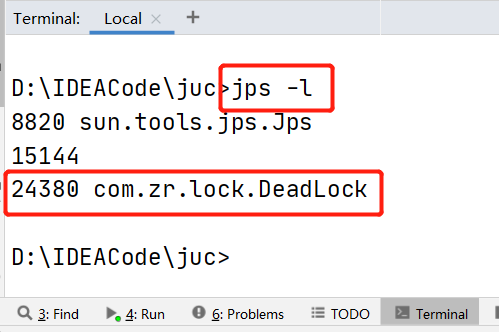
-
jstack 进程号(24380)

通过日志和堆栈信息排查问题!
文字截图来自 API 文档!